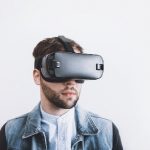VR’s ability to simulate real-life experiences makes it extremely powerful and valuable for the HR.
A decade ago, Virtual Reality is just science fiction. Now, it’s real and it’s being used by early adopters to great effect and varying degrees of success. Digital technology is transforming the Human Resources industry. Virtual Reality is no exception. In fact, 2017 consumers trends and opportunities for HR listed VR as one of the major technological advances that will transform the HR in the near future.
What is Virtual Reality?
According to Wired, Virtual Reality or VR is “a technology by which computer-aided stimuli create the immersive illusion of being somewhere else.” Unlike traditional interfaces, VR places users in a simulated environment where they can experience and interact with the 3D world around them.
VR is not just looking on a screen. Instead, it stimulates as many senses as possible including hearing, vision, touch, and in some more advanced programs, even smell. Don’t confuse Virtual Reality with Augmented Reality. The latter simulates artificial objects in the real world while the former creates an artificial environment altogether. You can think of Augmented Reality as VR with one foot in the real world.
Different Types of VR
Before we talk about how virtual reality works, it’s important to understand the different pathways that VR tech tends to follow. For now, there’s only two: stationary and mobile. Let’s talk about each one briefly below:
Mobile
This is the most common and most accessible type of VR. Mobile-based VR depends heavily on smartphones like Google’s Daydream View. You can also step up your VR experience by using Oculus Go or HTC Vive.
Stationary
Stationary VR uses standalone multi-projector setups in a room. The entire setup involves several components like gloves and controllers. Stationary VR tends to be more immersive and its applications go beyond the gaming industry. The only limiting factor of stationary setups is the cost.
How Virtual Reality Works
VR is still young technology. For now, there are two elements that makes VR work:
Head Tracking
Head tracking means that you wear a VR headset which projects pictures as you look up, down, sideways, or tilt your head in an angle. VR headsets use various internal components like accelerometers, magnetometer, and gyroscopes to keep track of your head movements. Head tracking needs a very low latency — approximately 50ms or less — to be effective. Users can also use headphones to increase the level of immersion.
Motion Tracking
In a virtual environment, the first thing you want to see when you look down is your hand in a virtual place. That’s the edge of motion tracking VR. Motion tracking VR techs use lasers or infrared to track your movements in a room.
Virtual Reality in HR
VR is slowly becoming mainstream. As the technology matures, businesses can use it to enhance day to day operations — especially the HR. Virtual Reality can be used to simulate real-world situations for employees, helping them gain perspective and prepare for actual work. The application of Virtual Reality in HR is almost endless. Below are some of them:
VR for Employee Onboarding
Employee onboarding can be a struggle for many organizations. A wrong onboarding process can kill the enthusiasm and productivity of a new hire. Not to mention it is quite time-consuming. VR technology can significantly improve your onboarding process. Imagine giving your new hire a virtual tour of your company wherever they are in the world.
Throw in a speech of the CEO and various encounters with fellow employees and the tour will become 10x better!
VR can be a cost-effective solution for companies with remote teams dispersed over many locations across the world. Virtual Reality can transform your onboarding program in three ways:
1. Gamification
Gamification is one of the most effective onboarding techniques. With VR, you can kick it up one notch higher! Imagine turning you 2-hour long presentation on company policies into a celebrity quiz show. Isn’t that amazing?
2. Team Assimilation
Do you know why many new hires quit within their first 6 months? It’s because they don’t feel like they’re part of the company. This is what happens when you have a broken onboarding experience. Virtual Reality can help bridge this gap by connecting teams and globally dispersed employees on a more personal level — virtually.
3. Functional Training
VR for functional training is an effective tool for onboarding employees whose jobs are dangerous, high-stress or require expensive/specialized machinery. This is not limited to medical or aerospace industries. You can also use it for the sales team, service people, etc.
Case Use: KFC Virtual Reality Training Video
VR for Recruitment
Virtual Reality can give candidates a taste of what it feels like working in your company from their home. Providing candidates with an immersive and engaging experience of the future work is a great way to attract talent. Below are three ways you can take advantage of this:
1. Gamifying the Application Process
Gamification gives you the opportunity to screen candidates based on skills and tactical knowledge needed to do the job. A classic example would be Jaguar Land Rover which uses an app that puts candidates inside a virtual garage full of iconic vehicles. Applicants explore the ins and outs of electric cars inside this virtual environment, showing their engineering and critical thinking abilities as they move from one code-breaking test to another. Applicants who do well in the game are fast-tracked through the application process.
2. A Day in the Life
How will you know if a potential hire is a great culture fit? In the past, it involves bringing them into your company and see if they will enjoy working there. But that is expensive, unscalable, and time-consuming. With VR, applicants can interact with potential colleagues, experience how meetings are done, and see first-hand your work processes without stepping into your office.
Deutsche Bahn introduced this VR experience in 2015 and as a result, interests in their job fairs increased by more than 400 per cent.
3. Showoff Your Workplace
Millennials and Gen Z workers love working in cool workplaces. So, if you have one, you can use Virtual Reality to invite potential hires inside your building without the need to coordinate and pay for hundreds of candidate visits.
Case Use: British Army Recruitment
VR for Training and Education
Employee training and education is probably the largest HR application of Virtual Reality. Below are the reasons why your business should start adopting it:
1. Improve Knowledge Retention
Do you still remember what you had for breakfast last week? If you can’t remember that, how do you expect employees to remember what they learned in training 6 months ago? Studies show that with traditional methods, workers can only remember as much as 50% of what they learned within an hour after the training.
Using VR for training, on the other hand, shows that participants retain up to 80% of the information after a year. Thanks to a fully immersive learning experience.
2. Reduce Workplace Accidents
New workers are 3 times more likely to suffer an injury compared to those who have been employed in the company for more than a year. Hands-on training is key to putting new hires up to speed. But, the real-work situation can be risky. And accidents are costly.
With Virtual Reality, companies can simulate a real-life work situation without putting employees in harm’s way.
3. Help Workers Learn Skills More Quickly
Do you know that it takes 6 months to 2 years for new hires to become fully productive employees? And that depends on the job they are filling in. Virtual Reality gives workers experiential learning opportunities with zero distractions. Hence, they pick up skills more quickly compared to putting them in a classroom or enrolling them in an online course.
When KFC introduced VR in their training, workers learned how to fry fried chickens in just 10 minutes. In real life, mastering this craft often takes 25 minutes.
Case Use: Aviation Industry Ground Operations Training
Are You Ready to Adopt Virtual Reality?
Adopting new technology is frightening — especially if you think that most HR executives did not grow up with Snapchat or YouTube. The leadership itself could be a barrier to the adoption of VR tech in your organization.
Another challenge is the experimental nature of new technologies. Virtual Reality is still far from perfect. However, early adopters will have the opportunity to work closely with VR tech providers to improve their services and solutions.
Lastly, to succeed in VR, you need to be able to connect it to your business’ needs. Remember that VR is an important business tool, not a must-have gadget. Use it to solve your business’ problems and once you have the solution, integrate it into your day to day processes.
If you think your organization can handle these barriers to adoption, then, by all means, go for it. Virtual Reality is an immersive technology that has a huge potential to overhaul and transform the way your business operates — for the better.
Some of the key benefits of Virtual Reality in HR include:
- Scalability
- Cost efficiency
- Improved quality
- Better candidate and employee experience
- Business image improvement (being known as an early adopter of innovations)
Norberts Erts is the co-founder of HR software company CakeHR, that streamlines attendance and performance management for customers worldwide. Keeping a sharp eye on HR, marketing, business, finance, science, technology and the connections between them. Connect with Norberts on Twitter or LinkedIn.








